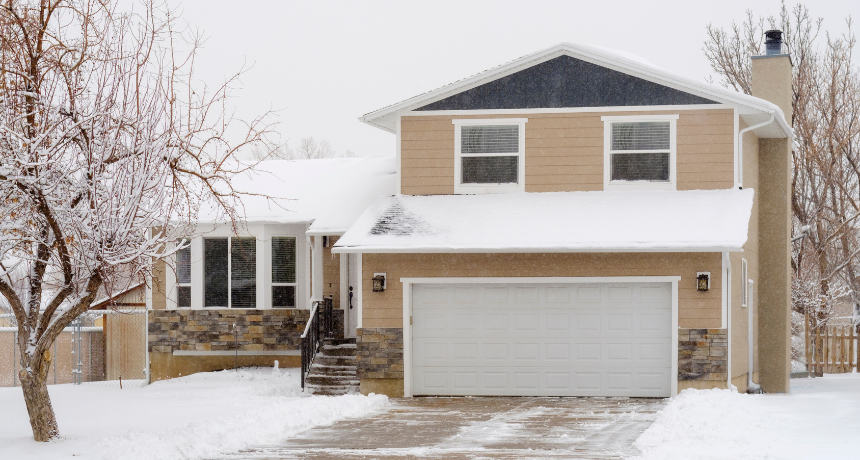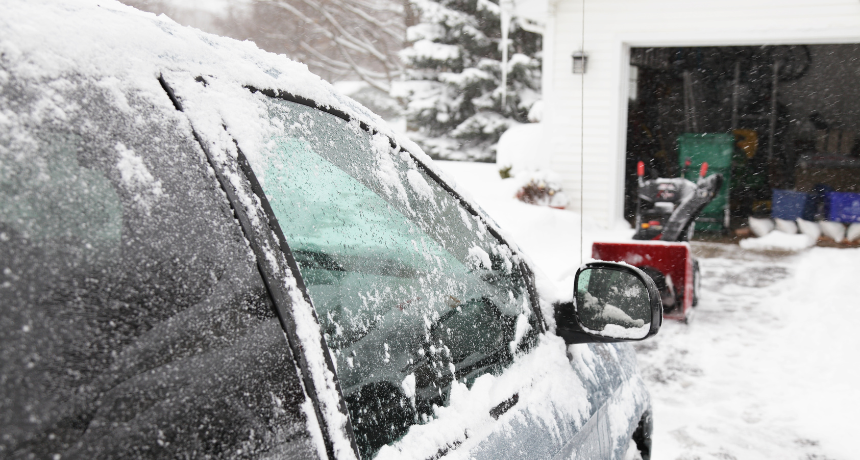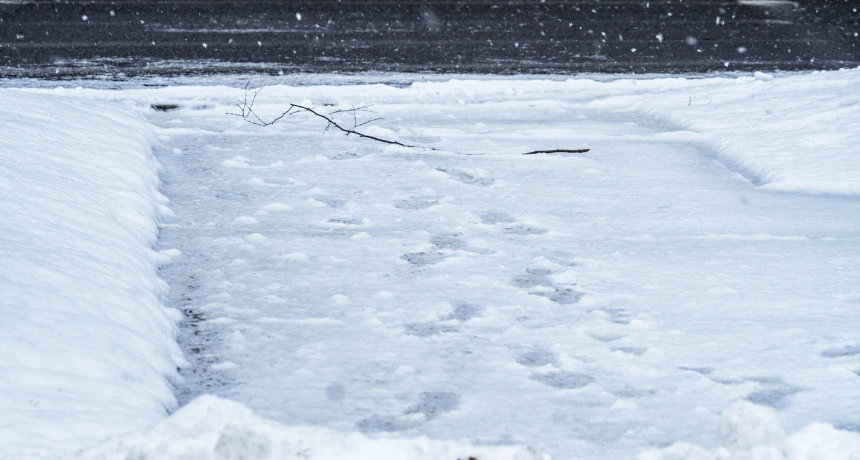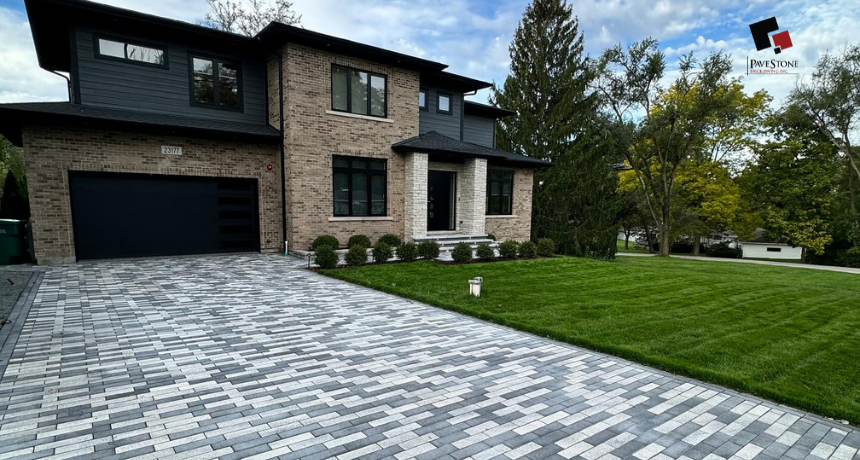As winter draws near in Chicago and the suburbs, it’s time to gear up for the task of clearing our driveways, especially if they’re paved with bricks. While many of us traditionally reach for salt to combat icy patches, it’s worth reconsidering this approach, particularly if you have a brick paver driveway. In this blog, we’ll explore why salt might not be the best choice and discuss simple alternatives to keep our driveways in good shape. Let’s find effective ways to navigate winter without causing issues for our outdoor spaces.

Why Salt isn’t the Ideal Solution for Snow Melting
When it comes to removing snow and ice from a brick driveway, using salt may not be the wisest choice, considering the potential drawback it brings. The primary culprit in salt, sodium chloride, poses a considerable risk to the well-being of the brick pavers. Over time, as the salt infiltrates the porous structure of the bricks, it initiates a process of deterioration and erosion. This gradual degradation doesn’t just compromise the structural integrity of the driveway; it also takes a toll on the visual appeal of the brick pavers, diminishing their distinctive charm.
Beyond its immediate impact on the driveway, the use of salt for melting snow carries environmental consequences. The runoff resulting from melted snow mixed with salt has the potential to harm nearby vegetation, giving rise to legitimate environmental concerns. This underscores the importance of exploring more sustainable alternatives.
Fortunately, there are gentler options available for winter maintenance that do not cause lasting damage. Let’s find out what these alternatives are and how they can effectively keep a brick driveway both functional and aesthetically pleasing without harming the environment.
9 Best Ways for Removing Snow and Ice
Consider these excellent alternatives when it comes to clearing a driveway coated in ice and snow:
1. Shovel Under Sun:
While perhaps not the most thrilling or time-efficient method, the classic pairing of a shovel and the sun stands as a dependable and proven approach for snow removal. Shoveling during the daytime is a smart choice for a few reasons. The natural sunlight makes it easier to see and clear away snow effectively. Plus, daytime temperatures are generally warmer, making the task more comfortable and helping to prevent ice from forming. It also helps in stopping the snow from getting packed down by foot traffic, keeping the surface easier to clear.
2. Snow Blower:
Not everyone finds joy in shoveling snow—it eats up time, and the physical strain can be stressful. Some people opt to hire a local plow service or seek help from a friendly neighbor. However, for those who enjoy taking matters into their own hands, a dependable snow blower is an excellent option. It allows you to clear icy driveways without relying on salt, and the good news is, it won’t harm your brick paver driveway. Snow blowers come in various types and power sources, including gas, corded electric, or battery-powered options, and they are available in different shapes and sizes. These machines are typically categorized into three main types: single-stage, two-stage, and three-stage blowers. To use a snow blower, set the direction and height for where you want the snow to go. Turn on the machine, push it into the snow, and guide it in a straight line to clear the snow effectively.

3. Snow Melting Mats:
A highly convenient and efficient way to address ice-related challenges on your property is by utilizing snow melting mats. These innovative devices are designed to eliminate the need for traditional methods such as rock salt or the laborious task of shoveling. Simply position the mats strategically on your driveway or porch, connect them to the nearest power outlet, and enjoy a hands-free solution. The mats use a heating mechanism to melt the ice, ensuring your pathways remain clear and safe. This not only simplifies the ice removal process but also adds a layer of safety and ease to maintaining your property during icy weather conditions.
4. Coffee Grounds:
Instead of discarding or composting coffee grounds, think about preserving them for winter use by de-icing your porch and driveway. Coffee grounds possess nitrogen, which lowers the melting point of ice. The dark hue of coffee grounds also absorbs sunlight, accelerating the thawing process for white snow or transparent ice. By repurposing coffee grounds in this way, you not only reduce waste but also tap into an eco-friendly method that can effectively combat icy conditions around your home. Unlike salt, coffee grounds are gentler on the environment, plants, and concrete surfaces, making them a more sustainable and effective choice.
5. Fertilizer:
Fertilizer can be a surprisingly good option for dealing with snow and ice on your paths and driveway. Certain fertilizers, like those containing ammonium sulfate or urea, can lower the freezing point of water, speeding up the melting process. Using fertilizer not only helps get rid of ice but also provides nutrients to the soil. Importantly, it’s a more environmentally friendly choice compared to salt. Unlike salt, which can harm plants and the environment, fertilizer offers a safer and more sustainable solution for handling winter ice.
6. Chloride Compounds:

Chloride compounds, such as calcium chloride or magnesium chloride, are excellent options for melting snow and ice. They work by preventing water from freezing, making them effective even in very cold temperatures. Calcium chloride, especially, produces heat upon contact with ice, speeding up the melting process. While these chloride-based de-icers are reliable, it’s important to use them carefully to avoid any harm to plants and the environment. When used responsibly, chloride compounds provide an efficient solution for addressing winter ice.
7. Vinegar:
Vinegar is a practical and eco-friendly option for getting rid of snow and ice on your driveway or walkway. It is acetic and works naturally to melt ice. The best part is that it’s gentler on the environment than using salt, which can be harmful to plants and surroundings. And since vinegar is a common household item, it’s an easy and cost-effective way to clear ice without using harsh chemicals.
8. Alcohol:
Alcohol can be a smart substitute for salt when dealing with icy surfaces. Mixing it with water creates a solution that prevents freezing and helps melt existing ice. Because alcohol has a lower freezing point, it works well even in really cold temperatures, making it a practical choice for sidewalks and brick driveways. Widely used in windshield de-icers, alcohol offers a less harmful option for the environment compared to regular salt
9. Sugar Beet Juice:
Sugar beet juice stands out as a fantastic substitute for traditional salt when it comes to melting snow on roads and paths. This natural solution, derived from sugar beets, contains a substance that prevents water from freezing, effectively stopping the formation of ice. It’s becoming increasingly popular in colder regions for de-icing because it’s eco-friendly and doesn’t harm the environment like salt does. Plus, it’s safe for plants and aquatic life, making it a smart and sustainable option for snow and ice management.
Conclusion

It’s essential to be proactive and have a plan in place before the snow arrives to avoid potential dangers from snow and ice buildup. If your brick paver driveway sustains any damage, Pavestone in Des Plaines, IL, is here to help. We specialize in brick paver driveway installations and repair. Feel free to reach out to us by calling 847-895-7004.














